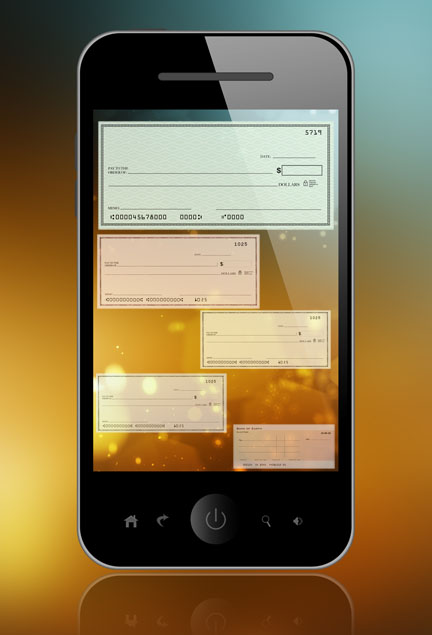Canadians will soon be able to use their smartphones to deposit a paper cheque into their bank accounts thanks to changes in the legal requirements for such transactions.
 The Image Rule Project was a five-year initiative aimed at enabling Canadian financial institutions and their clients to exchange payment items, such as cheques, electronically. Remote deposit capture has been common in the United States for several years but not in Canada.
The Image Rule Project was a five-year initiative aimed at enabling Canadian financial institutions and their clients to exchange payment items, such as cheques, electronically. Remote deposit capture has been common in the United States for several years but not in Canada.
Banks and credit unions will need to create mobile apps for deposit capture but the Canadian Payment Association rules finalized last week now allow it in Canada.
From a legislative perspective the first step was to amend the Canadian Bills of Exchange Act to enable the images of negotiable instruments such as cheques to have a legal status, says Vladimir Shatiryan, a lawyer with Blake Cassels & Graydon LLP.
Secondly, the Canadian Payment Association, which administers the clearing and payment of all items in Canada, had to have the necessary legal infrastructure in place to enable the exchange of image capture payment items through the CPA system.
“From the legal perspective, I think the path is clear in Canada to the extent that payment and clearing legislation is concerned for this kind of arrangement to be offered by financial institutions to their clients,” says Shatiryan.
The process took place over four phases beginning in 2008. Before the last phase was implemented Aug. 12, financial institutions that are members of the CPA were still able to exchange electronic payment items between themselves but needed to have detailed bilateral agreements to enable the exchange of payment items.
“Now with the Image Rule Project completed the rules of the Canadian Payment Association specifically addresses the exchange of electronic payment items through the payment and clearing system of the CPA. As long as a financial institution participates in the exchange of image captured payment items, then they would be able to clear and settle electronic cheques rather than on a bilateral basis,” Shatiryan adds.
Financial institutions need to now create their own infrastructure and smartphone apps to enable the feature to be used widely. Some credit unions have already started offering cheque imaging deposit.
The advantage is two-fold — consumers can now deposit cheques instantly using their smartphone rather than at the branch or ATM. For the banks it eliminates the expense of delivering the cheques physically to a clearing facility.
Cheque hold periods will still apply; an amount will be held and a re-charge arrangement will protect against fraud.
 The Image Rule Project was a five-year initiative aimed at enabling Canadian financial institutions and their clients to exchange payment items, such as cheques, electronically. Remote deposit capture has been common in the United States for several years but not in Canada.
The Image Rule Project was a five-year initiative aimed at enabling Canadian financial institutions and their clients to exchange payment items, such as cheques, electronically. Remote deposit capture has been common in the United States for several years but not in Canada.Banks and credit unions will need to create mobile apps for deposit capture but the Canadian Payment Association rules finalized last week now allow it in Canada.
From a legislative perspective the first step was to amend the Canadian Bills of Exchange Act to enable the images of negotiable instruments such as cheques to have a legal status, says Vladimir Shatiryan, a lawyer with Blake Cassels & Graydon LLP.
Secondly, the Canadian Payment Association, which administers the clearing and payment of all items in Canada, had to have the necessary legal infrastructure in place to enable the exchange of image capture payment items through the CPA system.
“From the legal perspective, I think the path is clear in Canada to the extent that payment and clearing legislation is concerned for this kind of arrangement to be offered by financial institutions to their clients,” says Shatiryan.
The process took place over four phases beginning in 2008. Before the last phase was implemented Aug. 12, financial institutions that are members of the CPA were still able to exchange electronic payment items between themselves but needed to have detailed bilateral agreements to enable the exchange of payment items.
“Now with the Image Rule Project completed the rules of the Canadian Payment Association specifically addresses the exchange of electronic payment items through the payment and clearing system of the CPA. As long as a financial institution participates in the exchange of image captured payment items, then they would be able to clear and settle electronic cheques rather than on a bilateral basis,” Shatiryan adds.
Financial institutions need to now create their own infrastructure and smartphone apps to enable the feature to be used widely. Some credit unions have already started offering cheque imaging deposit.
The advantage is two-fold — consumers can now deposit cheques instantly using their smartphone rather than at the branch or ATM. For the banks it eliminates the expense of delivering the cheques physically to a clearing facility.
Cheque hold periods will still apply; an amount will be held and a re-charge arrangement will protect against fraud.







